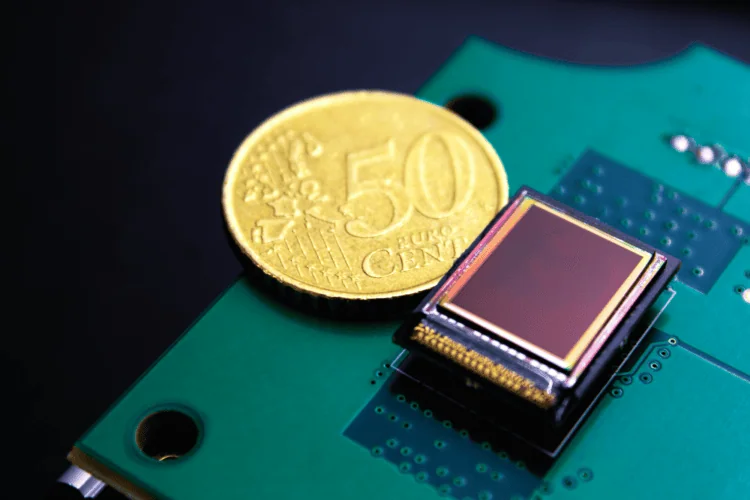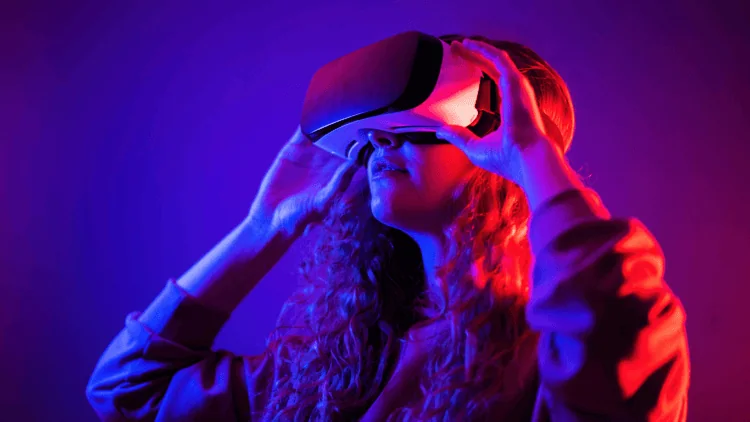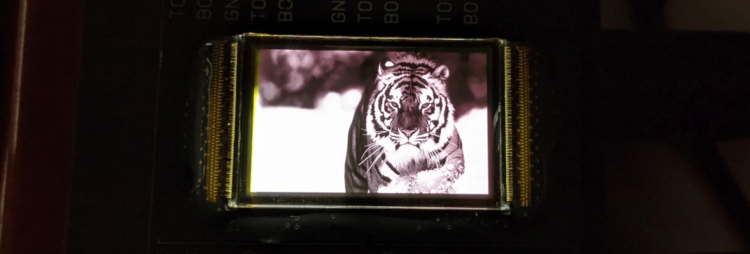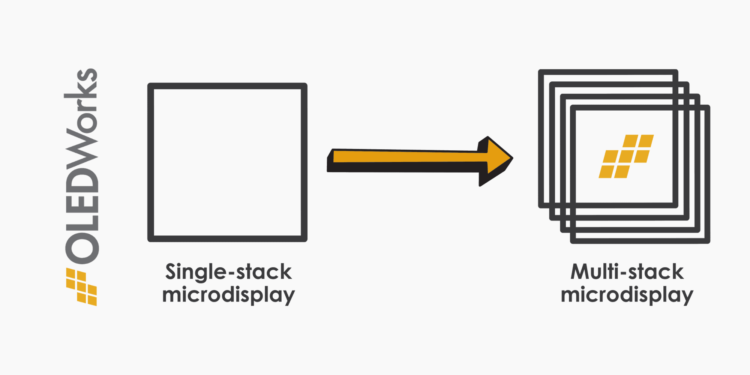
OLEDWorks is shaping the evolving landscape of display technology with groundbreaking multi-stack organic light emitting diode (OLED) solutions. With an innovative approach that increases color gamut, reduces power, and boosts lifetime, OLEDWorks offers a compelling combination of OLED microdisplay features for augmented reality and virtual reality (AR/VR) applications across different sectors of the near-eye display industry. Let’s take a closer look at multi-stack OLED microdisplays!
What is a Multi-Stack OLED Microdisplay?
It’s a teeny tiny display! Typically between 0.5 and 1.3 inches, from corner to corner, an OLEDWorks microdisplay consists of a CMOS silicon backplane that can host multiple stacks (e.g., 3, 4, 5, or even more) of ultra-thin, white-emitting OLED layers with a color filter. The CFs selectively transmit or absorb specific wavelengths of light to create red, green, and blue (RBG) pixels from the white OLED light.
The backplane is like the brain or control center, helping coordinate the flow of electrical power and other important information across the system. It has circuits on it that control individual pixels on the display. It receives image data and translates it into electrical signals that control each pixel’s state (e.g., on/off, brightness) and makes it possible to create beautiful, high-resolution images within such a small space.
OLEDWorks super extended graphics array (SXGA) microdisplay on a CMOS silicone backplane, with a Euro coin for size comparison. SXGA is a standard for display resolution that supports a maximum resolution of 1280 horizontal pixels by 1024 vertical pixels.
OLEDWorks’ multi-stack OLED technology is a breakthrough in the field of microdisplays. Each OLED layer emits light, which allows for an increase in brightness proportional to the number of stacks, without requiring higher current densities. Most OLED microdisplays currently on the market are made with 1-stack white OLED with CFs, which significantly limits the brightness and/or the operating lifetime of the display.
A multi-stack approach also supports optimization of the formulation, improving performance in ways not possible with one- and two-stack OLED formations. OLEDWorks’ unique approach provides a range of benefits that we’ll cover in the next section.
What are the Benefits of Multi-Stack OLED Microdisplays?
OLEDWorks’ pioneering multi-stack OLEDs promise to reinvent how we experience near-eye display technology. Imagine vivid colors and razor-sharp images, all packed into a sleek microdisplay within a head-mounted device.
Some of the key advantages that OLEDWorks’ multi-stack OLEDs offer over current single- or double-stack solutions include:
Unequalled Brightness
- Multi-stack OLED technology grants a significant increase in brightness without the need for higher current densities.
- Full-color multi-stack OLEDs achieve brightness levels of up to 10,000 cd/m² or higher. Monochrome green microdisplays can reach up to 100,000 cd/m².
High Color Gamut
- A significant improvement over existing solutions, multi-stack OLED architecture still produces a large color gamut, delivering vibrant and accurate colors.
- OLEDWorks’ ultra-thin color filters, enabled by an OLED formulation with a ‘peaky’, rather than flat white emission spectrum, also enhance overall color purity, resulting in stunning visuals.
OLEDWorks’ widescreen ultra-extended graphics array (WUXGA) microdisplay, showing an image of two elephants (Image sourced from Canva). WUXGA is a type of display resolution of 1920 horizontal pixels by 1200 vertical pixels.
Extended Lifetime
- OLEDWorks’ multi-stack microdisplays boast exceptionally long lifetimes—far surpassing industry standards.
- Brightness is also maintained over extended periods to ensure reliable performance.
Power Efficiency
- Multi-stack OLEDs are more power efficient than single stack displays at the same brightness level.
- The resulting reduced heat generation is a significant advantage for portable (particularly head-mounted) devices.
Contrast and Uniformity
- Despite its very high brightness, multi-stack OLED architecture enables a contrast ratio that exceeds 100,000:1.
- High uniformity also contributes to consistent display performance.
These benefits of multi-stack OLED microdisplays set them apart from single- or double-stack solutions and deliver a new level of performance for near-eye display technology. The advantages afford a more vivid, immersive experience and will continue to redefine the standards of the industry.
What are Some Applications for Multi-Stack OLED Microdisplays?
With breakthrough multi-stack microdisplay performance, OLED microdisplay technology is a superior choice for:
- Virtual reality (VR) applications: with high brightness levels, long lifetimes, and exceptional power efficiency, multi-stack OLEDs provide a much-needed enhancement to the luminance efficiency of VR displays and will facilitate a truly immersive experience. The high brightness of the multi-stack display allows for a low-duty cycle operation without compromising the light output of the display. Especially in VR applications, this feature can help to combat motion sickness that many VR users experience.
- Augmented reality (AR) applications: the high color gamut and power efficiency of multi-stack OLED technology helps make content more engaging and realistic. The ability to achieve high brightness levels while operating at low power levels is a significant advantage for AR displays. This is especially the case when the AR application is used outdoors, where the light of the display has to compete with potentially very bright ambient light.
OLEDWorks’ strategic display research and development is pushing the boundaries of luminance efficiency for microdisplays. This game-changing work yielded a recent contract with the United States Department of Defense (DoD) to develop high-brightness OLED microdisplays for head-mounted defense and consumer display applications. The full-color, high-resolution and high brightness microdisplays developed in partnership with the U.S. Government will leverage OLEDWorks’ current high volume multi-stack manufacturing processes for our specialty and automotive OLED lighting products.
Transforming Digital Experiences with Multi-Stack OLEDs
The advent of multi-stack OLEDs marks a significant milestone in the evolution of display technology. With unmatched brightness, high color gamut, superior contrast and uniformity, extended lifetime, and improved power efficiency, this high quality and cost-effective technology is poised to reimagine AR/VR applications.
OLEDWorks widescreen ultra-extended graphics array (WUXGA) microdisplay, showing an image of a mossy rock and water landscape (Image sourced from Canva).
OLEDWorks continues its leadership in the exciting field of microdisplays. As we look toward the future, the potential applications for multi-stack OLEDs are vast and varied, promising to transform not only the way we experience digital content, but also how we interact with the world around us.
Stay tuned for more updates as we continue to explore and innovate in the dynamic world of OLED microdisplay!







